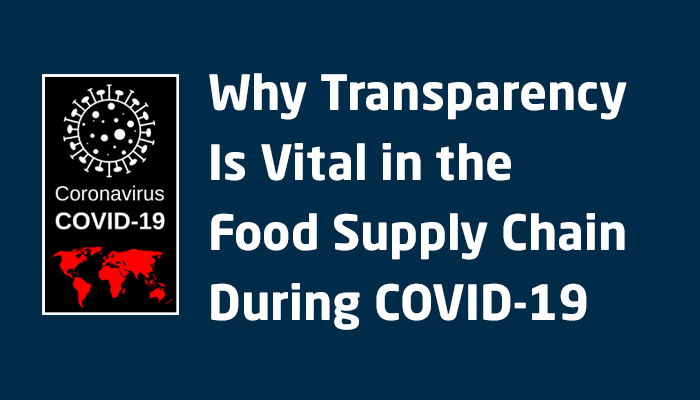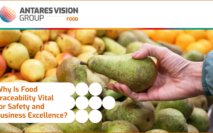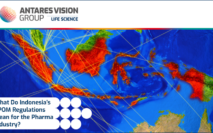The novel coronavirus pandemic has exposed vulnerabilities in food supply chains around the world. It’s also pushed the conversation about food supply chain transparency into the public square. Indeed, it’s likely that more people are thinking about supply chains today than at any other time in history.
However, it’s prudent to point out that the industry has resisted full end-to-end transparency. In light of the pandemic — and with the U.S. food supply chain in the news in recent weeks — we might have approached what’s commonly referred to as a teachable moment. The question is, will stakeholders finally realize that food supply chain transparency is in everybody’s best interest?
Why is there industry resistance to food supply chain transparency?
The main reason for resistance is that the industry views food supply chain transparency as a cost instead of an investment. As we pointed out in our “Seafood Supply Chain Traceability Trilogy,” it takes money — sometimes a lot of money — to implement the necessary systems.
Resistance also stems from the fact that supply chains weren’t really designed to be transparent. Companies see their supply chains as things to be guarded, proprietary infrastructure that’s nobody’s business but their own. Why should they “give away” information that could jeopardize their market position or possibly harm their reputation?
Another facet of this built-in opaqueness is that companies can’t always keep tabs on what their trading partners are doing. If an upstream or downstream partner is bending or breaking the law or otherwise doing something they shouldn’t, how can the company know? The gist of this problem is data: If it’s collected at all, it may be incomplete or just plain wrong.
And one final thought: Does the resistance mean the industry actually doesn’t want to be held accountable? Though some companies say that they care and want to held accountable, if they don’t embrace food supply chain transparency, this amounts to an empty promise and deflecting accountability to their trading partners.
Why we need food supply chain transparency in the time of COVID-19 — and beyond
The benefits of food supply chain transparency are not contingent upon world events (though transparency helps companies stay steady when events bring risk and uncertainty). They are what they are, no matter the circumstances. But the pandemic has illuminated the benefits, like a lightbulb going off over the collective head of the industry. Specifically, we need food supply chain transparency now for several key reasons:
- It decreases risk. Food supply chain transparency helps companies identify problems and risks before they escalate into a crisis (or crises). If all trading partners adhere to the same clear standards and can be held accountable for their actions, they’re more likely to self-govern to avoid trouble. Furthermore, with everybody “on the same team,” it’s significantly easier to solve a problem.
- It boosts efficiency. As we just said, food supply chain transparency gets everybody on the same team. And with teamwork comes efficiency. Stakeholders keep each another informed, enabling upstream and downstream trading partners to make better decisions, take pre-emptive action when needed (instead of waiting to react to a problem after the fact), and keep the supply chain moving.
- It helps increase the volume of actionable data. Transparency means being open about what you’re doing — which means sharing data about your operations with your partners, customers/consumers, regulatory agencies, and other stakeholders. With more high-quality data flowing inside and outside of the supply chain, every aspect of your operations can be improved.
- It encourages cooperation. When trading partners have seen their risks lowered and efficiency increased, they’ll be motivated, if not inspired, to cooperate more. Cooperation is great when things are going well; it’s even better if a problem arises. For example, if there’s a recall, everyone will know how to work together to get the product out of the supply chain.
- It increases supply chain resiliency. Transparency means you can know what’s going on in your supply chain, share information with your trading partners, put it in the context of events, and execute course corrections quickly. For example, if a factory closes due to a natural disaster, political unrest, or a pandemic, transparency intel empowers you assess the situation, see the real and potential impacts on your operations, and make necessary changes. All of this makes your organization more agile and the supply chain stronger.
- It inspires trust. The ultimate result of food supply chain transparency is trust among all supply chain stakeholders, from manufacturers all the way to consumers. Without trust, systems can break down. That’s the last thing you want to happen during a crises.
Final thoughts
rfxcel is committed to transparency in every supply chain — food and beverage, pharmaceuticals, consumer goods, and government. As we’ve shown, it’s an indispensable tool that’s more important today than ever before.
When external factors such as the current pandemic affect supply chains, transparency helps ensure products are delivered on time, safely, and to exactly the right location and/or person. It helps vital supply chains keep moving. It helps guarantee a product’s authenticity (i.e., no food fraud or counterfeit drugs). It helps protect the public health and safety.
For food supply chain transparency, our signature rfxcel Traceability System (rTS) offers the most complete and flexible raw materials and finished goods traceability solution for the industry. Our rfxcel MobileTraceability app heightens transparency even further, able to track any batch, movement, and handler at any location. And our rfxcel Integrated Monitoring (rIM) solution lets all stakeholders see their products in real time and mine rich unit-level data about more than a dozen environmental conditions.
Learn more about these and our other solutions for food and beverage here and contact us to start a conversation about transparency in your supply chain.





